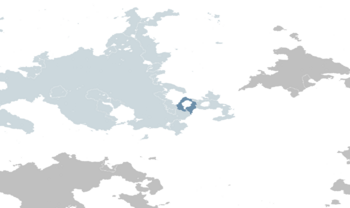Vermand: Difference between revisions
No edit summary |
No edit summary |
||
| Line 137: | Line 137: | ||
'''Vermand''' ({{wp|French language|Vermandois}}: Vermandé) officially the '''Kingdom of Vermand''' (Vermandois: Royaume de Vermandé) is a country located on the [[Anglish Peninsula]] in [[Parthenia|Eastern Parthenia]]. It is bordered by [[Angland]] and [[Brynmor]] to the east, [[Eisenland (Elezia)|Eisenland]] to the west and the [[Aurean Sea]] to the south. | '''Vermand''' ({{wp|French language|Vermandois}}: Vermandé) officially the '''Kingdom of Vermand''' (Vermandois: Royaume de Vermandé) is a country located on the [[Anglish Peninsula]] in [[Parthenia|Eastern Parthenia]]. It is bordered by [[Angland]] and [[Brynmor]] to the east, [[Eisenland (Elezia)|Eisenland]] to the west and the [[Aurean Sea]] to the south. | ||
Inhabited by early humans since the {{wp|Paleolithic}}, the land was settled in the {{wp|Iron Age}} by a Celtic tribe known as the {{wp|Gauls|Volcens}}. The area was annexed by the [[Remillian Empire|Remillians]] as early as 61 BC, which lead to a unique culture and language influenced by both Latin and {{wp|Gaulish|Volcennic}}, this paved way for the evolution of the {{wp|French language|Vermandois language}}. Upon the collapse of the Remillian Empire, the Eisen {{wp|Franks|Vermans}} formed the First [[Kingdom of the Vermans]]. After the [[Treaty of Vérodonne]] in 843, [[East Vermandia]] became the predecessor of Vermand, and [[West Vermandia]] became that of Eisenland and Livania. Vermandia was among the last surviving Livanic kingdoms from the Migration Period era before its partition in 843. This was succeeded by [[Charles the Great]]'s [[Caroleon Empire]]. During the Childerian and Carolean dynasties the Vermandish realm was one large polity subdivided into several smaller kingdoms, often effectively independent. | |||
==Etymology== | ==Etymology== | ||
==History== | ==History== | ||
Revision as of 20:11, 30 April 2023
This article is incomplete because it is pending further input from participants, or it is a work-in-progress by one author. Please comment on this article's talk page to share your input, comments and questions. Note: To contribute to this article, you may need to seek help from the author(s) of this page. |
Kingdom of Vermand
2 other official names
| |||||
|---|---|---|---|---|---|
Motto:
| |||||
| Anthem: "Le chant du départ" | |||||
 Vermand Parthenia | |||||
| Capital | Beaumont | ||||
| Official languages | Vermandois Gascon | ||||
| Recognised regional languages | Compiègnois | ||||
| Ethnic groups | See Ethnicity | ||||
| Demonym(s) | Vermandois | ||||
| Government | Unitary constitutional monarchy | ||||
• King | Jean V | ||||
• Prime Minister | Nathalie Perrault | ||||
| Legislature | Parliament of Vermand | ||||
| Population | |||||
• 2022 estimate | |||||
• 2018 census | 67,841,235 | ||||
• Density | 121.1/km2 (313.6/sq mi) | ||||
| GDP (PPP) | 2022 estimate | ||||
• Total | |||||
• Per capita | $47,952 | ||||
| HDI | 0.901 very high | ||||
| Currency | Franc (VDF) | ||||
| Date format | dd.mm.yyyy | ||||
| Driving side | right | ||||
| Calling code | +078 | ||||
| ISO 3166 code | .VR | ||||
Vermand (Vermandois: Vermandé) officially the Kingdom of Vermand (Vermandois: Royaume de Vermandé) is a country located on the Anglish Peninsula in Eastern Parthenia. It is bordered by Angland and Brynmor to the east, Eisenland to the west and the Aurean Sea to the south.
Inhabited by early humans since the Paleolithic, the land was settled in the Iron Age by a Celtic tribe known as the Volcens. The area was annexed by the Remillians as early as 61 BC, which lead to a unique culture and language influenced by both Latin and Volcennic, this paved way for the evolution of the Vermandois language. Upon the collapse of the Remillian Empire, the Eisen Vermans formed the First Kingdom of the Vermans. After the Treaty of Vérodonne in 843, East Vermandia became the predecessor of Vermand, and West Vermandia became that of Eisenland and Livania. Vermandia was among the last surviving Livanic kingdoms from the Migration Period era before its partition in 843. This was succeeded by Charles the Great's Caroleon Empire. During the Childerian and Carolean dynasties the Vermandish realm was one large polity subdivided into several smaller kingdoms, often effectively independent.
Etymology
History
Prehistory
Geography
Biodiversity
Climate
Politics and Government
Foreign Relations
Military
Administrative Divisions
Law
Law Enforcement
Economy
Primary sector
Secondary sector
Tertiary sector
Quarternary sector
Energy
Natural resources
Demographics
Urbanization
Immigration
Religion
Languages
Education
Healthcare
Culture
See Also
References






